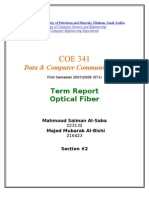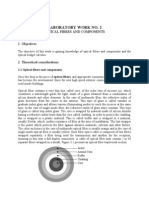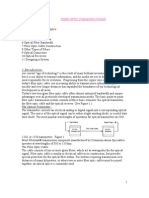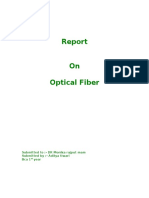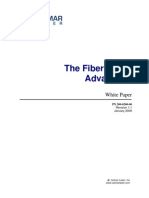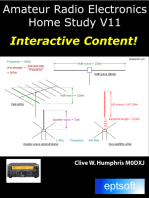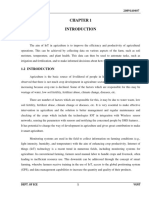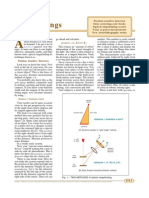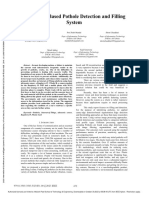IJSRDV2I3225
IJSRDV2I3225
Uploaded by
Lizin SmackzCopyright:
Available Formats
IJSRDV2I3225
IJSRDV2I3225
Uploaded by
Lizin SmackzOriginal Description:
Copyright
Available Formats
Share this document
Did you find this document useful?
Is this content inappropriate?
Copyright:
Available Formats
IJSRDV2I3225
IJSRDV2I3225
Uploaded by
Lizin SmackzCopyright:
Available Formats
IJSRD - International Journal for Scientific Research & Development| Vol.
2, Issue 03, 2014 | ISSN (online): 2321-0613
Laser Torch based Voice Transmitter and Receiver
K. Govinda1 Waseem Arshad2 Santosh Ram3 Shashank Agrawal4
1
SCSE, University, Vellore, India
2, 3, 4,
SENSE, VIT University Vellore, India.
Abstract---In this paper we designed the circuit, using that 10. Laser transmitter and receiver units ensure easy,
circuit we can communicate with our neighbors wirelessly. straightforward systems alignment and long-term stable,
Instead of RF signals, light from an IR LED is used as the service free operation, especially in inaccessible
carrier in the circuit. The laser torch can transmit light up to environments, optical wireless systems offer ideal,
a distance of about 500 meters. The phototransistor of the economical alternative to expensive leased lines for
receiver must be accurately oriented towards the beam from buildings.
the LED. If there is any obstruction in the path of the beam,
no sound will be heard from the receiver. The transmitter II. LITERATURE REVIEW
circuit comprises of condenser microphone transistor The laser-induced lubricant pockets generated high local
amplifier BC548 followed by an op amp stage built around pressures and thus caused a thicker lubricant film, allowing
µA741. The gain of the op-amp can be controlled with the an optimal separation of the contact surfaces even at lower
help of 1-mega-ohm potentiometer VR1.The AF output sliding velocities [2]. It transmits high quality audio and the
from IC1 is coupled to the base of transistor BD139 (T2), link is virtually impossible for anyone else to tap into. An
which, in turn, modulates the beam. The transmitter uses 9V important feature of transmission by laser beam is privacy.
power supply. The receiver circuit uses an NPN Because a laser beam is intentionally narrow, it's virtually
phototransistor as the light sensor is followed by a two-stage impossible for someone to tap into the link without us
transistor preamplifier and LM386-based audio Power knowing. If someone intercepts the beam, the link is broken,
amplifier. The receiver does not need any complicated signaling the interception.
alignment. Just keep the phototransistor oriented towards the Fibre-optic cables also have high security, as it's
remote transmitters beam. The phototransistor is kept away very difficult to splice into the cable without breaking the
from AC light sources such as bulbs. The reflected sunlight, link. However it's theoretically possible; so for the highest
however, does not cause any problem. But the sensor should security, we probably cannot beat a line-of-sight laser beam.
not directly face the sun. Also it cannot be detected with use of spectrum analyzers
and RF meters and hence can be used for diverse
I. INTRODUCTION applications including financial, medical and military.
An infrared light-emitting diode (LED) is a type of Laser Surface Texturing (LST) is probably the
electronic device that emits infrared light not visible to the most advanced so far. LST produces a very large number of
naked eye. An infrared (IR) LED operates like a regular micro-dimples on the surface and each of these micro-
LED, but may use different materials to produce infrared dimples can serve either as a micro-hydrodynamic bearing
light. This infrared light may be used for a remote control, to in cases of full or mixed lubrication, a micro-reservoir for
transfer data between devices, to provide illumination lubricant in cases of starved lubrication conditions, or a
for night vision equipment, or for a variety of other micro-trap for wear debris in either lubricated or dry sliding
purposes. This prototype model can be used for higher [3]. Lasers can also transmit through glass; however the
ranges using a laser light instead of an IR LED which will physical properties of the glass have to be considered. By
enhance the working of the model. Laser as a rotating the media under the focused pulsed‐laser beam, a
communication medium can provide a good substitute for row of crater shaped dimples are created in the landing zone
the present day communication systems as the problem of only [4]. Laser transmitter and receiver units ensure easy,
interference faced in case of electromagnetic waves is not straightforward systems alignment and long-term stable,
there and high deal of secrecy is available. It will easily give service free operation, especially in inaccessible
a communication distance of several hundred meters, and environments, optical wireless systems offer ideal,
with a parabolic light reflector, up to several kilometers. economical alternative to expensive leased lines for
buildings [5, 7].
A. Advantages:
Over the past 10 Years, laser intensities have
1. Less costly increased by more than four orders of magnitude to reach
2. Circuit can be easily constructed enormous intensities of 1020 W /cm2 [6].The laser can also
3. High data rate be commissioned in satellites for communication, as laser
4. No communication licenses required. radar requires small aperture as compared to microwave
5. The laser transmission is very secure because it has radar. As we cannot see the laser beam without special IR
a narrow beam. sensitive equipment, it also makes alignment more difficult.
6. There are no recurring line costs. Further, potential bandwidth of radar using lasers can
7. Compatibility with copper or fiber interfaces and no translate to very precision range measurement. For these
bridge or router requirements. reasons, they can be used as an alternative to present modes
8. Lasers can also transmit through glass; however the of communication. Laser communication is both wide-band
physical properties of the glass have to be considered. and high-speed.
9. Narrow beam divergence
All rights reserved by www.ijsrd.com 397
Laser Torch based Voice Transmitter and Receiver
(IJSRD/Vol. 2/Issue 03/2014/108)
III. PROPOSED METHODOLOGY end, and the laser diode at the other end. The electronics
The block diagram of working principle of the system is modulates the intensity of the laser beam according to the
shown in Figure 1. output of the microphone. The laser diode has an inbuilt
collimating lens, and is simply a module that connects to the
transmitter board. The receiver uses a photodiode as the
receiving element, and the onboard amplifier powers a small
4-36 ohm speaker. This board is therefore a high gain
amplifier with a basic audio output stage. But what about
results - are they better? Sure. Because this design uses a
Fig.1: Block Diagram of Working Principle of System. higher power (and visible) laser beam, the range is
The transmitter section comprises condenser improved, and alignment is easier and not all that critical,
microphone, transistor amplifier BC548 followed by an op- especially over a few hundred meters. The quality of sound
amp stage built around IC1. The gain of the op-amp can be transmitted by the link is quite surprising. Clearly, this
controlled with the help of 1-mega ohm pot meter VR1. The project is ideal for setting up a speech channel between two
AF output from IC1 is coupled to the base of transistor areas, say adjacent houses or offices on opposite sides of the
Bd139, which in turn, modulates the laser beam. The street. Or you could use it as a link between the work shop
transmitter uses 9V power supply. However, the 3-volt laser and the house. For duplex (two way) communication, you'll
torch (after the removal of its battery) can be directly obviously need two laser channels. An important feature of
connected to the circuit with the body of the torch connected transmission by laser beam is privacy. Because a laser beam
to the emitter of BD139 and the spring loaded lead is intentionally narrow, it's virtually impossible for someone
protruding from inside the torch to circuit ground. The block to tap into the link without you knowing. If someone
diagram of transmitting section is given in Figure 2. intercepts the beam, the link is broken, signaling the
interception. Fibre-optic cables also have high security, as
it's very difficult to splice into the cable without breaking
the link. However it's theoretically possible; so for the
highest security, you probably can't beat a line-of-sight laser
beam. Where the transmission distance is no more than
meter of so, a LED (or two for increased power) can be
substituted for the laser diode. For instance, where the link
is being used for educational purposes, such as
demonstrating fibre- optic coupling, or the concept of
communication over a light beam. Obviously the security of
the transmission is much lower as LEDs transmit light in all
directions. While this laser link can be adapted for use as a
perimeter protector. Now to a description of how it all
Fig. 2: Block Diagram of Transmitting Section. works, it's really very simple. We'll start with the
The receiver circuit uses an NPN phototransistor as transmitter.
the light sensor that is followed by a two stage transistor A. Transmitting section
preamplifier and LM386-based audio power amplifier. The
receiver doesn't need any complicated alignment. Just keep
the phototransistor oriented towards the remote
transmitter's laser point and adjust the volume control for a
clear sound. The block diagram of receiving section is
shown in Figure in 3.
Fig. 4: The transmitter
A laser diode needs a certain value of current,
called the threshold current, before it emits laser light. A
further increase in this current produces a greater light
Fig. 3: Block Diagram of Receiving Section output. The relationship between output power and current
The two sections: the transmitter board and the in a laser diode is very linear, once the current is above the
receiver board are both powered by a separate 9V battery or threshold, giving a low distortion when the beam is
a fixed voltage power supply, depending on the needs. The amplitude modulated. For example, the 65Onm 5mW laser
transmitter board has an electret microphone module at one diode used in this project has a typical threshold current of
All rights reserved by www.ijsrd.com 398
Laser Torch based Voice Transmitter and Receiver
(IJSRD/Vol. 2/Issue 03/2014/108)
3OmA and produces its full output when the current is signal. The signal is them coupled through C8 toVR2. VR2
raised by approximately 1OmA above the threshold to is a volume control for IC2. IC2 amplifies the signal more
4OmA.Further increasing the current will greatly reduce the and drives the speaker, LS1.
life of the laser diode, and exceeding the absolute maximum
of 8OmA will destroy it instantly. Laser diodes are very IV. CONCLUSION
fragile and will not survive electrostatic discharges and After the successful working of the project, it can be
momentary surges! However, if used within specifications, concluded that this project is suitable for easily
the typical life of one of these lasers is around 20,000hours. communication. There can be further up gradations in the
In the transmitter circuit (Fig.4) the laser diode is supplied project which could lead to a much better system for
via an adjustable constant-current source. Note that the communication. A possible way is instead of the short
metal housing for the laser diode and the lens also acts as a range laser, high range lasers can be used which range a few
heat sink. The laser diode should not be powered without the hundred meters. Provisions have to be made for cases when
metal housing in place. The increasing the voltage at there is no heavy traffic. Using this circuit we can
VR 1 reduces the laser current. The setting of communicate with our neighbors wirelessly. It can be also
VR 1determines the quiescent brightness of the laser beam, used in inaccessible areas and conference halls. In future, it
and therefore the overall sensitivity of the system. The can be commissioned in satellite for communication and
electric microphone is powered through R 1and is coupled instead of the short range laser, high range lasers can be
to the non-inverting input of 1C1a via capacitor. This input used which range a few hundred meters Provisions have to
is held at a fixed DC voltage to give a DC output to bias. be made for cases when there is no heavy traffic.
The mic is the audio input. C1is a coupling
capacitor that connects the audio from the mic to T1. T1is a REFERENCES
transistor that is used to amplify the audio a bit. C2 couples
[1] Etsion, I. and Burstein, L., “A Model for Mechanical
the audio to IC1which amplifies it some more. The audio
Seals with Regular Microsurface Structure,” Tribology
from the IC is then routed to T2 which modulates the power
Transactions, Vol. 39, pp. 677–683, 1996.
to the LED. This puts the audio onto the light beam. VR1 is [2] Geiger, M., Roth, S., and Becker, W., “Influence of
a variable resistor which adjusts the gain of the IC. C3, C4 Laser-Produced Microstructures on the Tribological
andR7 are power filters that remove noise from the power
Behavior of Ceramics,” Elsevier, Surface and Coatings
supply. The other resistors just supply the right voltage to
Technology, Vol. 101, pp. 17–22, 1998.
the various parts.
[3] Etsion, I., “State of the Art in Laser Surface Texturing,”
B. Receiver section J. of Tribology Trans. ASME, Vol.127, pp. 248–
253,2005.
[4] Ranjan, R., Lambeth, D.N., Tromel, M., Goglia, P., and
Li, Y., “Laser Texturing for Low-Flying-Height
Media,” J. of Applied Physics, Vol. 69, pp. 5745–5747,
1991.
[5] Geiger, M., Popp, U., and Engel, U., “Eximer Laser
Micro Texturing of Cold Forging Tool Surface-
Influence on Tool Life,” , Elsevier Annals of the CIRP,
Vol. 51, pp. 231–234, 2002.
[6] A.Braun, G. Kern, X. Liu, D. Du, J. Squier, and G.
Mourou, “ Ultrahigh-intensity laser: physics of the
extreme on a tabletop “ , Springer, Berlin, Vol. 60, p.
248-265, 1994.
[7] C. V. Shank. Kaiser,” Ultrashorf Laser Pulses and
Applications”, Springer-Verlag, Berlin, Vol. 60, pp. 5-
Fig. 5: The Receiver 34, 1988.
The transmitted signal is picked up by the photo [8] A. Pukhov and J. Meyer-ter-Vehn, “Relativistic
detector diode in the receiver (shown in Fig.5). The output Magnetic Self-Channeling of Light in Near-Critical
voltage of this diode is amplified by the common emitter Plasma: Three-Dimensional Particle-in-Cell
amplifier around T4. This amplifier has a gain of 20 or so, Simulation” Phys. Rev. Left., Vol. 76, pp. 3975-3978,
and connects viaVR2 to IC2, an LM386 basic power 1996.
amplifier IC with a gain internally set to20.This IC can drive [9] Electronic Communication System: George Kennedy
a speaker with a resistance as low as four ohms, and [10] www.electronicsforyou.com
35OmWwhen the circuit is powered from a 9V supply. [11] www.wikipedia.org
Increasing the supply voltage will increase the output power [12] http://www.scribd.com/doc/48917961/Laser-Torch-
marginally. Incidentally, the photodiode used for this project based-Voice-Transmitter-and-Receiver
has a special clear package, so it responds to visible light, [13] onlinepresent.org proceedings vol3 3 4 .pdf
and not just infrared.T3 is a photo sensitive transistor which
receives the laser from the LED transmitter. The transistor
puts out a signal that is proportional to the light from the
LED. This not only receives the signal it also demodulates
it. C5 couples this audio to T4 and T5 which amplify the
All rights reserved by www.ijsrd.com 399
You might also like
- (Electromagnetics and Radar) Robert B. McShea - Test and Evaluation of Aircraft Avionics and Weapon Systems (2014, SciTech Publishing) PDFDocument1,041 pages(Electromagnetics and Radar) Robert B. McShea - Test and Evaluation of Aircraft Avionics and Weapon Systems (2014, SciTech Publishing) PDFSergioSalazar100% (3)
- ISO 7027 Turbidity TechniqueDocument2 pagesISO 7027 Turbidity TechniqueGustavo Sánchez0% (1)
- Concise Guide to OTN optical transport networksFrom EverandConcise Guide to OTN optical transport networksRating: 4 out of 5 stars4/5 (2)
- BOSCH CCTV TrainingDocument115 pagesBOSCH CCTV TrainingRizwan Shaikh100% (1)
- Trilogy of Wireless Power: Basic principles, WPT Systems and ApplicationsFrom EverandTrilogy of Wireless Power: Basic principles, WPT Systems and ApplicationsNo ratings yet
- Project ReportDocument35 pagesProject ReportNitish Gupta100% (2)
- Free Space Optical CommunicationDocument25 pagesFree Space Optical CommunicationParth Vineel GargNo ratings yet
- Witblox Mega Diy Robotics Kit PDFDocument40 pagesWitblox Mega Diy Robotics Kit PDFSARIB ARIFNo ratings yet
- Laser Transmitter and ReceiverDocument8 pagesLaser Transmitter and ReceiverMikhael MachaNo ratings yet
- 592 970 1 PBDocument5 pages592 970 1 PBDevasis HNo ratings yet
- University of Tripoli: Laser Based Wireless Optical Voice Transmission SystemDocument10 pagesUniversity of Tripoli: Laser Based Wireless Optical Voice Transmission SystemOula FraiwanNo ratings yet
- Report On PC To PC Laser CommunicationDocument20 pagesReport On PC To PC Laser CommunicationRajashri BhamareNo ratings yet
- Project 1 (Laser Audio Transmitter)Document4 pagesProject 1 (Laser Audio Transmitter)Komal GargNo ratings yet
- Data & Computer Communications: Term Report Optical FiberDocument15 pagesData & Computer Communications: Term Report Optical FibersarinapNo ratings yet
- Role of Opto Electronic Devices in Optical CommunicationDocument13 pagesRole of Opto Electronic Devices in Optical CommunicationPradyumna Arjun0% (1)
- Optoelectronics Digital Assignment 2 ECE 1007 Pramit Paul 17BEE0345 Optoelectronic Components and Their FeaturesDocument13 pagesOptoelectronics Digital Assignment 2 ECE 1007 Pramit Paul 17BEE0345 Optoelectronic Components and Their FeaturesPramit PaulNo ratings yet
- Report On Electromagnetic Wave DetectorDocument16 pagesReport On Electromagnetic Wave DetectorRahul TripathyNo ratings yet
- PC To PC Communication Using LaserDocument53 pagesPC To PC Communication Using Lasersandarbh588% (8)
- Laboratory Work No. 2: Optical Fibers and ComponentsDocument8 pagesLaboratory Work No. 2: Optical Fibers and Componentsuser_iuliNo ratings yet
- Laser Torch Based Voice Transmitter and Receiver (Repaired)Document56 pagesLaser Torch Based Voice Transmitter and Receiver (Repaired)1deakz4lu7ge100% (3)
- A Project Report On Free Space Optical Link: Submitted By, Nikunj GabaniDocument13 pagesA Project Report On Free Space Optical Link: Submitted By, Nikunj GabaniNikunj GabaniNo ratings yet
- Fibre Optic CommunicationsDocument11 pagesFibre Optic CommunicationsmycatalystsNo ratings yet
- Laser Torch-Based Voice Transmitter and ReceiverDocument35 pagesLaser Torch-Based Voice Transmitter and Receiversagar95% (21)
- Government Engineering College, Bilaspur: AssignmentDocument7 pagesGovernment Engineering College, Bilaspur: AssignmentJinius MishraNo ratings yet
- Chapter-1 Wireless Communication - Laser CommunicationDocument84 pagesChapter-1 Wireless Communication - Laser CommunicationMohammad ShoebNo ratings yet
- Free Space Laser CommunicationsDocument21 pagesFree Space Laser CommunicationsAnkit GuptaNo ratings yet
- Part 2Document14 pagesPart 2raedprimNo ratings yet
- Optical Fibre CommunicationDocument60 pagesOptical Fibre CommunicationN.ChanduNo ratings yet
- Block Diagram of Optical Communication SystemDocument18 pagesBlock Diagram of Optical Communication SystemSuhana Sharma100% (4)
- Wireless Transmission of Telemetry Data Via Laser BeamDocument4 pagesWireless Transmission of Telemetry Data Via Laser BeamBijay MaharjanNo ratings yet
- Laser CommunicationDocument84 pagesLaser CommunicationKaushal VermaNo ratings yet
- Optical TechnologyDocument34 pagesOptical Technologyavi100% (1)
- Optical Fibre CommunicationDocument60 pagesOptical Fibre CommunicationashjunghareNo ratings yet
- Laser CommunicationsDocument19 pagesLaser Communicationssampu809691No ratings yet
- Acknowledgement: Features of Laser Communications SystemDocument24 pagesAcknowledgement: Features of Laser Communications SystemHarini SridharanNo ratings yet
- Fiber Optic Cable Course 1672068566Document69 pagesFiber Optic Cable Course 1672068566xjykdm5cyhNo ratings yet
- Submitted to:-DR Monika Rajput Mam Submitted By: - Aditya Tiwari Bca 1 YearDocument14 pagesSubmitted to:-DR Monika Rajput Mam Submitted By: - Aditya Tiwari Bca 1 YearjamesNo ratings yet
- SUBIN K M Freespace Laser CommunicationsDocument31 pagesSUBIN K M Freespace Laser Communicationsapi-3827000100% (3)
- Seminar On Laser Communications: Submitted To: Submitted byDocument19 pagesSeminar On Laser Communications: Submitted To: Submitted byPallavi VermaNo ratings yet
- Foc Unit 1 and 2Document70 pagesFoc Unit 1 and 2Naveen KumarNo ratings yet
- WPC Laser CommunicationDocument20 pagesWPC Laser CommunicationHussein AliNo ratings yet
- EC2405 Optical and Microwave Lab VivaDocument6 pagesEC2405 Optical and Microwave Lab VivaShreyas MaheshNo ratings yet
- Light Sources Used in Fiber Optical CommunicationDocument9 pagesLight Sources Used in Fiber Optical CommunicationthatoneJgd100% (1)
- Ajay Kumar Garg Engineering College: OFC Characteristics, Modes & Splicing and Synchronous Digital Hierarchy (SDH)Document25 pagesAjay Kumar Garg Engineering College: OFC Characteristics, Modes & Splicing and Synchronous Digital Hierarchy (SDH)Rishi SrivastavaNo ratings yet
- Tarun Solutions For AOCN QBDocument54 pagesTarun Solutions For AOCN QBTarun Kumar GoyalNo ratings yet
- Fiber Optics TutorialDocument15 pagesFiber Optics TutorialdioumbNo ratings yet
- Fiber Laser Advantage Rev 1.1 010109Document8 pagesFiber Laser Advantage Rev 1.1 010109rajeevNo ratings yet
- (R20) OfcDocument243 pages(R20) OfcShameemNo ratings yet
- Irjet V4i48045 PDFDocument4 pagesIrjet V4i48045 PDFHitesh AhujaNo ratings yet
- Komponen Sistem Komunikasi Serat OptikDocument84 pagesKomponen Sistem Komunikasi Serat OptikGamaliel SyikalNo ratings yet
- Seminar ReportDocument11 pagesSeminar ReportdevasheeshNo ratings yet
- Laser Torch Based Voice Transmitter and ReceiverDocument30 pagesLaser Torch Based Voice Transmitter and ReceiverUma Mahesh60% (5)
- Communication Skills of Group DiscussionDocument5 pagesCommunication Skills of Group DiscussionShambhavi BiradarNo ratings yet
- Fibre Optics CommunicationDocument21 pagesFibre Optics CommunicationJoshua DuffyNo ratings yet
- Tunable Laser Technology: Technical Seminar-IDocument15 pagesTunable Laser Technology: Technical Seminar-IYemula Ajay100% (1)
- Glossary BK Fop TM AeDocument87 pagesGlossary BK Fop TM AetengudanNo ratings yet
- Amateur Radio Electronics on Your MobileFrom EverandAmateur Radio Electronics on Your MobileRating: 5 out of 5 stars5/5 (1)
- Real-Time Heat Input Monitoring Towards Robust GMA Brazing: Science and Technology of Welding and JoiningDocument12 pagesReal-Time Heat Input Monitoring Towards Robust GMA Brazing: Science and Technology of Welding and JoiningrishiNo ratings yet
- An Inspection Robot Using Infrared Thermography For Belt ConveyorDocument6 pagesAn Inspection Robot Using Infrared Thermography For Belt ConveyorJoão SoaresNo ratings yet
- IoT Agriculture ReportDocument51 pagesIoT Agriculture ReportSruthi Reddy0% (1)
- TNB190RevC - FlexRadar Forming Process Monitor SystemDocument8 pagesTNB190RevC - FlexRadar Forming Process Monitor SystemJohan LorcaNo ratings yet
- (PTZ Indoor) Ds-2de2204iw-De3 - SpecDocument3 pages(PTZ Indoor) Ds-2de2204iw-De3 - SpecAngga SenjayaNo ratings yet
- Tech Musings: Don Lancaster'sDocument6 pagesTech Musings: Don Lancaster'schaulin08No ratings yet
- Overview of Lans and Wireless Lan Technology and Applications Transmission Techniques of Wireless LansDocument36 pagesOverview of Lans and Wireless Lan Technology and Applications Transmission Techniques of Wireless LansKaynz SkueaNo ratings yet
- Remote Sensing of Environment: John C. Mars, Lawrence C. RowanDocument15 pagesRemote Sensing of Environment: John C. Mars, Lawrence C. RowanasfasdfadsNo ratings yet
- Infrared Plastic Solar Cell ReviewDocument7 pagesInfrared Plastic Solar Cell ReviewNagendra babu PasupuletiNo ratings yet
- Automatic Open Drain Cleaning SystemDocument5 pagesAutomatic Open Drain Cleaning SystemIJRASETPublicationsNo ratings yet
- Preliminary Study of Near Surface Detections at Geothermal Field Using Optic and SAR ImagerieDocument3 pagesPreliminary Study of Near Surface Detections at Geothermal Field Using Optic and SAR ImagerieaghiNo ratings yet
- Wireless Networks NotesDocument20 pagesWireless Networks Noteskundan100% (3)
- A621421 PDFDocument127 pagesA621421 PDFAwaisMushtaqNo ratings yet
- Photogrammetry and Remote SensingDocument14 pagesPhotogrammetry and Remote SensingJoseph Dincht83% (6)
- Elettronica Pratica 1972 - 01Document10 pagesElettronica Pratica 1972 - 01rikyNo ratings yet
- Sekotech CatalogDocument48 pagesSekotech CatalogIonut PopescuNo ratings yet
- Photo NotesDocument19 pagesPhoto NotesReen DousNo ratings yet
- Building Thermography (Preview)Document36 pagesBuilding Thermography (Preview)Davide Lanzoni100% (2)
- D 1619 - 99 - Rde2mtktukveDocument4 pagesD 1619 - 99 - Rde2mtktukveDr. Ahmed Abdel-HakimNo ratings yet
- Script Komik : SectorsDocument31 pagesScript Komik : SectorsTricia OfeliaNo ratings yet
- Smart IOT Based Pothole Detection and Filling SystemDocument6 pagesSmart IOT Based Pothole Detection and Filling Systemsepovo6879No ratings yet
- Fire Sprinkler System Fundamental of Design & InstallationDocument227 pagesFire Sprinkler System Fundamental of Design & InstallationKamal Ahmed100% (2)
- Dalal Et Al., 2024Document10 pagesDalal Et Al., 2024Zabdi Sarai Reyes RodríguezNo ratings yet
- Uputstvo - Capelec CAP3600Document69 pagesUputstvo - Capelec CAP3600Samir ČičakNo ratings yet
- 2013 Catalogue Hills Home HubDocument14 pages2013 Catalogue Hills Home HubDavidBuNo ratings yet














